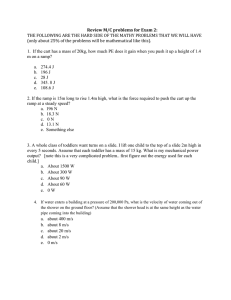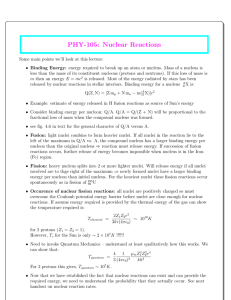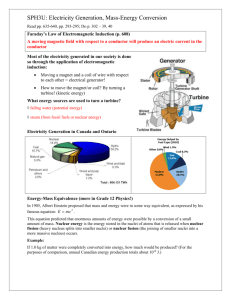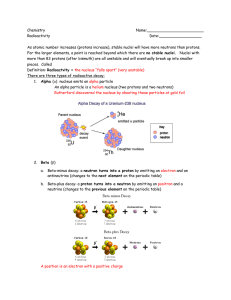Nucleus Chapt 8
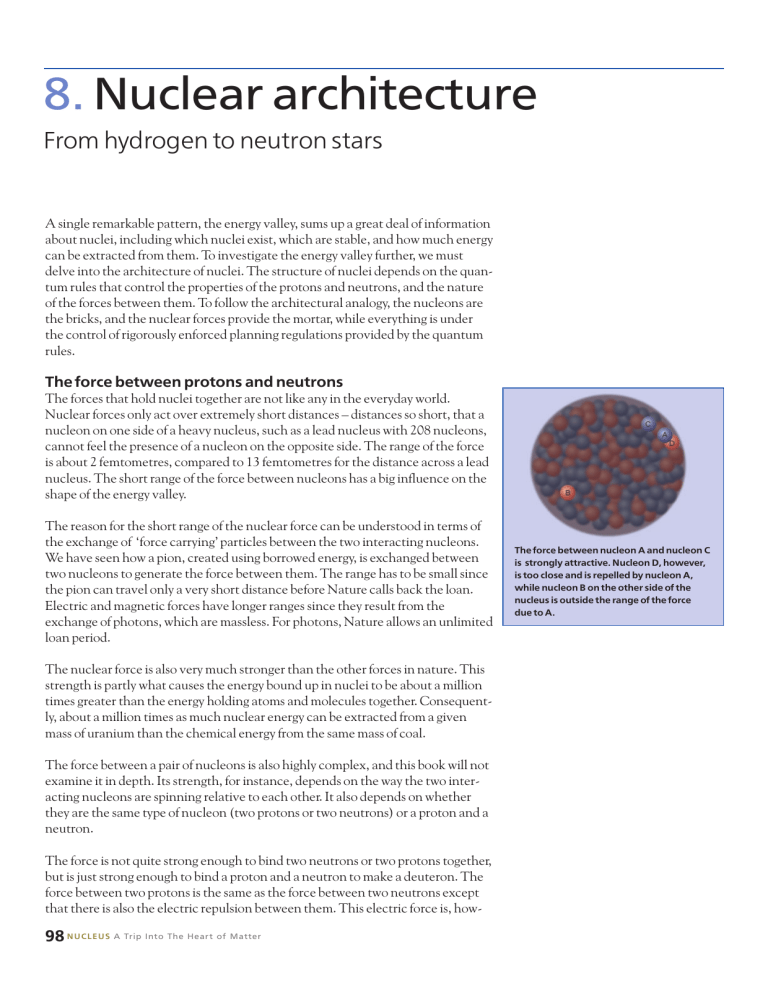
8.
Nuclear architecture
From hydrogen to neutron stars
A single remarkable pattern, the energy valley, sums up a great deal of information about nuclei, including which nuclei exist, which are stable, and how much energy can be extracted from them. To investigate the energy valley further, we must delve into the architecture of nuclei. The structure of nuclei depends on the quantum rules that control the properties of the protons and neutrons, and the nature of the forces between them. To follow the architectural analogy, the nucleons are the bricks, and the nuclear forces provide the mortar, while everything is under the control of rigorously enforced planning regulations provided by the quantum rules.
The force between protons and neutrons
The forces that hold nuclei together are not like any in the everyday world.
Nuclear forces only act over extremely short distances – distances so short, that a nucleon on one side of a heavy nucleus, such as a lead nucleus with 208 nucleons, cannot feel the presence of a nucleon on the opposite side. The range of the force is about 2 femtometres, compared to 13 femtometres for the distance across a lead nucleus. The short range of the force between nucleons has a big influence on the shape of the energy valley.
The reason for the short range of the nuclear force can be understood in terms of the exchange of ‘force carrying’ particles between the two interacting nucleons.
We have seen how a pion, created using borrowed energy, is exchanged between two nucleons to generate the force between them. The range has to be small since the pion can travel only a very short distance before Nature calls back the loan.
Electric and magnetic forces have longer ranges since they result from the exchange of photons, which are massless. For photons, Nature allows an unlimited loan period.
The force between nucleon A and nucleon C is strongly attractive. Nucleon D, however, is too close and is repelled by nucleon A, while nucleon B on the other side of the nucleus is outside the range of the force due to A.
The nuclear force is also very much stronger than the other forces in nature. This strength is partly what causes the energy bound up in nuclei to be about a million times greater than the energy holding atoms and molecules together. Consequently, about a million times as much nuclear energy can be extracted from a given mass of uranium than the chemical energy from the same mass of coal.
The force between a pair of nucleons is also highly complex, and this book will not examine it in depth. Its strength, for instance, depends on the way the two interacting nucleons are spinning relative to each other. It also depends on whether they are the same type of nucleon (two protons or two neutrons) or a proton and a neutron.
The force is not quite strong enough to bind two neutrons or two protons together, but is just strong enough to bind a proton and a neutron to make a deuteron. The force between two protons is the same as the force between two neutrons except that there is also the electric repulsion between them. This electric force is, how-
98
NUCLEUS A Trip Into The Hear t of Matter
ever, completely overwhelmed by the nuclear force when the protons are close together, but is significant for two protons on opposite sides of a large nucleus.
Another feature of the force between two nucleons is that it changes from being attractive to repulsive at very short distances so that two nucleons cannot overlap
(under normal conditions) in a nucleus.
The nuclear force is incredibly finely balanced. A few percent stronger and two protons (or two neutrons) would bind together. Nuclei consisting of just two protons do not exist, but if they did all the hydrogen would have been consumed in the Big Bang leaving none to power ordinary stars, including the Sun. It would then have been impossible for life to evolve on Earth. A few percent weaker and the deuteron would not be bound. Most of the energy from the Sun comes from a process which starts with the formation of deuterium, so if this occurred, again life would not have evolved on Earth. In either case, the elements produced in the later stages of the Big Bang would have been quite different.
Quantum rules rule
According to quantum theory, a proton or a neutron does not have a particular place in a nucleus in the same way that a brick has a fixed location in a house.
Each proton and neutron has a probability density that is spread throughout the nucleus. There are more and less likely places for a nucleon to be found, as determined by its wave function. This is the mathematical rule specifying the probability for a nucleon to be found at any particular place. It describes an orbit, a little like the orbit of electrons in atoms and not at all like the orbits followed by planets. While it is difficult to visualize electrons in their smeared out orbits around nuclei, it is even harder to imagine how nucleons might move round in the crowded nucleus.
Nucleon orbits have one dramatic property: the less spread out in space an orbit is, the more energy of motion (technically, the kinetic energy) the nucleon has.
This is one aspect of Heisenberg’s Uncertainty Principle and is the main reason why nuclei do not collapse to a point even though the very strong nuclear force is pulling each nucleon towards its neighbours. The fact that the nuclear force between nucleons becomes repulsive at very short distances stops the nucleus being quite a point, but without the Uncertainty Principle nuclei would definitely be much smaller.
This very sharp peak from electron scattering experiments shows that the 82nd proton in lead is most likely to be found near the centre of the nucleus. The outer rings show that the neutron can also be found at about 4 and 7 femtometres from the centre of the nucleus.
In most cases, the last proton in a nucleus does not have such a large probability of being at the centre of the nucleus.
If a nucleus was smaller, each orbit would have to be more compact simply to describe the smaller volume in which a proton is found. The Uncertainty Principle imposes a cost for this to happen: in a smaller volume, the energy of motion becomes larger, which means energy needs to be added to a nucleus to make it smaller. As a result, nuclei are highly incompressible. The actual size of a nucleus with a particular number of nucleons is a balance between the nuclear forces pulling the nucleons together and the Uncertainty Principle keeping them apart.
Two other factors work together with the Uncertainty Principle to dictate nuclear sizes. One is the repulsive part of the force that takes over when nucleons get very close to each other. The other is the quantum rule known as the Pauli exclusion principle. This dictates that only two protons and two neutrons can occupy each possible quantum orbit.
Every orbit must obey the Uncertainty Principle, but some orbits are more compact than others. Nucleons fall preferentially into the innermost, most
NUCLEUS A Trip Into The Hear t of Matter
compact, unfilled orbits. Adding nucleons to a nucleus progressively fills up shells, making it bigger. The nucleus grows in such a way that its central density remains close to the characteristic density for the centre of all nuclei. In this respect, nuclei are very different from atoms, which are all roughly the same size. In atoms, all the electron orbits get smaller as electrons are added. This is because an atom will only be able to accommodate more electrons if its nucleus has more protons, and this extra positive charge draws all the electron orbits inwards. There is nothing equivalent at the centre of the nucleus to pull in the nucleon orbits.
Two contrasting pictures
Two quite different pictures of nuclei have been presented. On the one hand, protons and neutrons within nuclei lie in orbits much as electrons in atoms, but on the other hand nuclei behave in many ways as if they were made of incompressible fluid. All nuclei except the very lightest have the same density, much as water droplets all have the same density. If the nucleons are so closely packed together it is hard to see how they could possibly be orbiting around inside the nucleus at the same time. Water molecules certainly do not travel in simple orbits within a water droplet.
The energy valley reflects the two contrasting aspects. In the first place it has an overall smooth structure which can be summed up in just three curved lines: the height of the valley floor (below), the parabola on the following page, and the bend in the line of black squares in the Segrè chart (page 71) as N becomes greater than Z for the heavy stable nuclei. However, the basically smooth valley is crossed by a number of small ditches or gullies following the lines of the magic numbers.
It turns out the magic numbers are a signature that nucleons lie in simple orbits.
Are nuclei, then, like water droplets or like miniature solar systems with nucleons in orbits? The answer is that they are not quite like either but are somewhat like both. This might seem paradoxical, but our expectations are formed by our experience with the world of visible things, and the quantum world is very different.
A droplet of nuclear material
Consider the way the floor of the energy valley first slopes down as we move from the lightest stable nuclei until it reaches its lowest point around iron and nickel, and then slowly rises again towards the heavy nuclei. This overall behaviour can be explained in terms of the average force felt by each nucleon.
The floor of the energy valley showing where some particular nuclei lie. The height is the energy per nucleon, labelled E/A. It is lowest near iron (Fe), highest near the lightest nuclei such as hydrogen (H), and gradually becomes higher for elements heavier than iron.
The shape of the energy valley explains why energy is released by fusion of light nuclei and by fission of heavy nuclei.
100
NUCLEUS A Trip Into The Hear t of Matter
Nucleons deep within a nucleus ‘feel’ the attractive force of nucleons surrounding them, as if they have bonds tying them to other nuclei. Nucleons at the surface have fewer such bonds, and the net result is that the total number of bonds per nucleon is much less for nuclei with fewer nucleons, since most nuclei in such nucleons are at the surface.
Moving up from the bottom of the valley floor, energy increases as the proton number and neutron number change for a fixed number of nucleons, in this case
137. The proton number is shown after the name of the element, but all elements are
137
Te,
137
I, etc.
The short range of the nuclear force means that in any nucleus, the nucleons in the surface ‘feel’ the attractive force of a smaller number of other nucleons than those deep within a nucleus. In light nuclei, a higher fraction of the nucleons are near the surface so, overall, these nuclei have less binding energy than heavier ones.
One way of expressing this is by saying that light nuclei have extra energy, called surface energy, making them more weakly bound. All nuclei, visualized as droplets of nuclear matter, would have the same average energy per nucleon were it not for additional effects such as the surface energy, which is largest for the lightest nuclei, making them less stable. This is reflected in the steep upward rise of the floor of the valley at the low Z end.
The slow increase in energy, and decrease in stability, towards the heaviest nuclei is mainly due to the electrostatic repulsion between the protons. Although the electrical force is much weaker than the nuclear force, its longer range makes it important for larger nuclei. Every proton in a nucleus feels the attractive nuclear force only of its nearest neighbours, but feels the repulsive electrostatic force of every other proton in the nucleus. This repulsion therefore builds up as the number of protons increases, so that nuclei become less tightly bound as Z increases.
NUCLEUS A Trip Into The Hear t of Matter
101
Electrostatic repulsion plays a role in other features of the energy valley. Consider the ‘parabolic’ down-and-up shape of the energy for a series of nuclei with the same total number of protons and neutrons. For a heavy nucleus, the minimum energy (most stable nucleus) occurs when there is a particular, considerable, excess of neutrons over protons. In quantum mechanics, if the protons did not repel each other then the minimum energy would occur for equal numbers of protons and neutrons. This energy would rapidly increase when there is an unequal number of protons and neutrons. The effect of the electrostatic repulsion between the protons is dramatic: the minimum energy is increased for all nuclei, but far more for nuclei with a large excess of protons. Thus the minimum energy occurs for nuclei with more neutrons than protons. These effects become larger for heavy nuclei, which have more mutually repelling protons.
The nature of the nuclear force and the quantum rules explains the overall shape of the energy valley: the way it arcs away from the diagonal N=Z line towards the neutron rich side, and the slow rise of the valley floor up towards the heavy nuclei.
More about nucleon orbits
The picture of the nucleus as a droplet of nuclear matter is incomplete. Such a picture cannot explain the gullies crossing the valley at the magic numbers.
To understand these we require the completely different picture of a nucleus as a collection of nucleons in orbit.
A very familiar collection of bodies in orbit is the Solar System with planets orbiting the Sun. A nucleus is very different. Firstly, there is no heavy central object like the Sun holding the nucleons in orbit. The force each nucleon feels is an average force due to all the other nucleons. Secondly, of course, protons and neutrons exist in the tiny world where quantum rules are supreme. According to these rules, it is not possible to say that a proton or neutron is ‘at’ some particular place, something certainly possible with planets. All that can be said is how likely it would be to find a nucleon at a particular place at a particular moment. The nuclear equivalent to the planetary orbit is the quantum orbit described by a wave function specifying the places where a nucleon would be found if its position were measured.
The fact that no more than two protons or neutrons can occupy each orbit is crucial. The idea of orbits being ‘occupied’ is a key to the magic numbers. In the same way that electron orbits in a hydrogen atom only have particular energies, each proton orbit corresponds to a possible energy for a proton within the nucleus.
The same is true for neutrons. This means there are families of nucleon orbits with similar energies with the number of orbits in each family fixed by quantum rules.
102
NUCLEUS A Trip Into The Hear t of Matter
If there were no repulsion between protons, the energy would be lowest when the number of protons, Z, was the same as the number of neutrons, N. The most stable nuclei would have the same number of protons and neutrons as shown by the green line. This tends to be true for nuclei with less than 20 protons. Where there is a proton excess, there is additional energy, indicated by the red vertical lines. This is due to the repulsion between all the protons and is larger the greater the excess of protons. The total energy is shown by the blue line, and at its lowest point there are more neutrons than protons. This is why heavy nuclei have more neutrons than protons.
Periodic table of the elements
The chemical properties of the elements have a periodic behaviour. For example, the elements on the far right of the Periodic
Table shown above – helium, neon, argon, krypton, xenon and radon – are all inert gases. They are particularly stable and do not need to form compounds with other elements. This is because their atoms have filled shells of electrons.
As protons are added to a nucleus, the orbits are filled family by family. When all the orbits in a family are full, the nucleus is especially stable and has a lower energy than it would have otherwise. The corresponding number of protons is a magic number, and the energy of nuclei with this number of protons will dip down below the average energy of nearby nuclei – such nuclei lie in a gully crossing the energy valley. For example, since 28 and 50 are consecutive magic numbers, the family of orbits that starts with the 29th proton, and is filled with the 50th proton, must have 50 – 28=22 members. That is, it is a family of orbits that can accommodate
22 protons.
Neutron magic numbers arise in exactly the same way. The only difference is that for heavier nuclei the neutron orbits fill more easily since they do not have to worry about electrostatic repulsion. For example, the especially stable lead isotope
208
Pb has magic number 82 protons and magic number 126 neutrons.
Something very similar occurs with atoms. These are also particularly stable when all the places in a family of electron orbits are filled. These are the atoms of the inert or noble gases.
Nuclear shapes revisited
Liquid drops have a strong tendency to be spherical. This can be seen in film clips showing droplets floating in the gravity-free environment of an orbiting space station. For water droplets, as well as for nuclei, a particle in the surface feels the attractive force of fewer other particles than would be felt by a particle in the interior. So it is ‘energetically favourable’ to minimize the surface area, and spheres have the least possible surface area for a given volume. According to this argument, nuclei should also be spherical.
Many nuclei, however, are not spherical. This is a result of the nucleon orbits.
The magic numbers mentioned above, 2, 8, 20, 28, 50, 82 and 126 apply to spherical nuclei. It turns out that there are other numbers that are ‘semi-magic’
NUCLEUS A Trip Into The Hear t of Matter
103
if the nucleus has a non-spherical shape (referred to as deformed). This occurs because, for particular neutron numbers, the orbits for the last few neutrons are naturally deformed. For example, the isotope of the element of samarium with 86 neutrons,
148
Sm, is a typical spherical nucleus, but the isotope with 90 neutrons,
152
Sm, is deformed like an American football.
The energy of these orbits is lowered when the nucleus as a whole becomes deformed. As a result, nuclei with particular combinations of neutron number
(or proton number) and American-football shape have lower energy than they would have otherwise. Such nuclei prefer not to be spherical. The effect of these semi-magic numbers on the energy valley is not as dramatic as the effect of the spherical magic numbers, but it is sufficient for many nuclei to be at their most stable when deformed.
For spherical nuclei, the magic numbers are well defined, so 30, 52 or 80 are definitely not magic although 28, 50 and 82 are. The number 90 marks the beginning of a whole range of neutron numbers for which the stable nuclei are deformed. This also happens with proton number 90 (thorium) so that thorium, uranium (Z=92) and plutonium (Z=94), the nuclei particularly associated with nuclear fission, are all deformed. This deformation, even for their most stable isotopes, gives these nuclei a start on the road to fission.
A deformed nucleus can be made to rotate, and this makes the phenomenon of super-deformation possible. When a nucleus rotates very fast, the resulting centrifugal force felt by its nucleons lowers the energy of particular highly non-spherical orbits. This results in the nucleus becoming stretched in a super-deformed shape.
Nuclear fission revisited
Today, the two pictures of nuclei – as droplets of nuclear matter, and as nucleons in orbit – are seen as complementary aspects of a more comprehensive picture. Both models provide useful insights in particular situations, for example, they both play a role in the description of nuclear fission.
The outermost proton and neutron orbits of a uranium nucleus have a lower energy when the nucleus is deformed. The energy would be higher if the nucleus were either spherical or more deformed. The energy for such different shapes can be calculated.
The energy is lowest when the nucleus has the slight American-football deformation that uranium nuclei are found to have. To stretch a uranium nucleus until it is more deformed than its natural shape requires a great deal of energy. This can be thought of as an energy ‘hill’. Once over the hill, the energy in the nucleus falls rapidly. Thus if the nucleus could become deformed just enough to get to the top of the energy hill, it would then split apart into two fragments.
The nucleons in each fragment would no longer feel the attraction from the nucleons in the other fragment, but they would still feel the effect of the electric charge of the other fragment’s protons. The two fragments would thus be thrust apart with great force. The fact that there is less energy within the two fragment nuclei than the original nucleus means that a great deal of energy has been released. This becomes the energy of motion of the two fragments which ends up as random motion of the surrounding atoms (or heat).
104
NUCLEUS A Trip Into The Hear t of Matter
A pulse of neutrinos from supernova SN
1987A arrived on cue at the Kamiokande observatories underground neutrino detector in Japan. The designation 1987A identifies the supernova as the first to be observed in 1987.
The only problem with this picture of nuclear fission is that the nucleus does not have enough energy to reach the top of the energy hill. Quantum mechanics provides a way for this to happen by permitting a small probability of the nucleus tunnelling through the energy hill leading to spontaneous fission. This is the same tunnelling process by which an alpha particle emerges from a nucleus in alpha decay.
Sometimes energy from outside the nucleus makes it easier to surmount the fission barrier. This is what happens when a
235
U nucleus absorbs a neutron.
The incoming neutron places the resulting ‘compound nucleus’
236
U in an excited state and the extra energy allows it to overcome the fission barrier.
Neutron stars: the largest nuclei
One force of Nature has been ignored completely in our account of nuclei, the force of gravity. It is 10
40 times weaker than the electrostatic force and makes absolutely no measurable contribution to the binding of atomic nuclei. It is certainly important to us, however, being the reason we do not require tethering to Earth with ropes.
Gravity differs from the electromagnetic force in that there are no such things as
‘like’ and ‘unlike’ gravitational charges: everything attracts everything else and there is no repulsion. In spite of the electromagnetic force being immensely more
The arrow points to a neutron star at the head of the ‘bowshock nebula’, created as it sweeps at enormous speed through the tenuous gas and dust of space. It is rather like the bow wave of a ship travelling through the sea. The star itself is the very faint, blue object near the very tip of the cone. Most neutron stars are not visible, but this one is at a temperature of about 700,000 degrees, and it is probably heated by the very high speed impact of gas and dust. This is the closest known neutron star to the Sun, and presents a wonderful opportunity to study neutron stars.
(Courtesy European Southern Observatories.)
NUCLEUS A Trip Into The Hear t of Matter
105
powerful than gravity, almost everything around us on the macroscopic scale is neutral and electric forces mostly go unnoticed. When natural processes do separate some positive and negative charge, they tend to get back together quite dramatically. An example of this is lightning.
In spite of the weakness of gravity, there do exist ‘nuclear’ systems in the cosmos where gravity plays a crucial role. These are neutron stars. When a giant star, many times the mass of the Sun, comes to the end of its life, it undergoes a colossal explosion, becoming a supernova and briefly shines as brightly as an entire galaxy. If the conditions are right, it leaves behind a compact object about 10 to
15 km across (the size of a city) but with a mass at least 1.4 times that of the Sun.
It consists largely of neutrons, the protons in the core of the star having combined with electrons under the pressure of the explosion to form neutrons and neutrinos. The neutrons remain as a neutron star. Vast quantities of neutrinos spread through space at the speed of light. In spite of their weak interactions with matter, a few might be detected on Earth in underground detectors like
Kamiokande in Japan.
Surprisingly, perhaps, many of the properties of neutron stars can be understood directly from the properties of nuclear matter within nuclei. This is a huge extrapolation since the largest atomic nuclei have about 300 nucleons. Gravity acting within neutron stars makes it possible to have a bound object with about
10
53 times as many nucleons, most of which are neutrons. It is remarkable that information from the shape of the energy valley can be extended all the way to neutron stars.
A crucial property is the incompressibility of nuclear matter. The pressure due to gravity acting at the centre of an object 10 km across, but with a mass greater than the Sun, is enormous. In spite of this pressure, the average density of a neutron star is about the same as that of an atomic nucleus: about 3x10
14 times as dense as water. Only at the very centre does the pressure make it perhaps two or three times as dense as ordinary nuclei.
While the general properties of neutron stars are reasonably well understood, they raise many interesting questions that have yet to be answered. The full understanding of neutron stars demands a more detailed knowledge of the behaviour of nuclear matter at high temperatures and pressures. This is a powerful motivation for many experiments at accelerator laboratories such as RHIC, GSI and elsewhere in which high energy heavy nuclei are smashed together, producing for a brief instant some of the conditions within both neutron stars and the explosions which gave birth to them.
Shells of star material ejected into space from the star that left behind supernova 1987A in the
Large Magellanic Cloud. The neutron star at the centre has not yet been identified. (Courtesy
European Southern Observatories.)
All nuclei have much the the same density, and unless they have been heated up in a nuclear collision they are ‘cold’. But nuclear material can be compressed to a higher degree in neutron stars and heated up in supernova explosions. The Big
Bang was exceptionally hot, and nuclear material then took the form of quark–gluon plasma, which is a different phase of nuclear material; much as ice and steam are different phases of water. In a collision between heavy nuclei at very high energies, nuclear matter will follow the path of the green line. This takes it out into the quark–gluon plasma region.
106
NUCLEUS A Trip Into The Hear t of Matter
The discovery of neutron stars – Jocelyn Bell Burnell
Jocelyn Bell Burnell and the Cambridge radio telescope. (Courtesy Jocelyn Bell Burnell.)
In the late 1960s quasars (quasi-stellar radio sources) had recently been discovered to be very distant, luminous objects which allowed the study of an early phase of the Universe. A radio survey of the sky, to discover more of them was started in Cambridge (UK). The radio telescope specially built, in-house, for the project spread over 2 hectares and consisted of 2,048 dipoles operating at 81.5 MHz. The signals received by the radio telescope were recorded on strips of paper chart (no computers were available). The sky was repeatedly surveyed, each scan lasting 4 days, and producing 120 metres of paper chart. As the research student on the project I was responsible for running the survey and analysing the paper charts.
Occasionally on those 120 metres of chart there was about 0.5 centimetres of signal that puzzled me. It did not look like a quasar, nor did it did it look like locally generated radio interference that intermittently swamped the weak cosmic radio signals. The curious signal was very weak, was often not present, and moved across the sky with the stars.
Just as I focussed attention on it, it weakened and dropped to a level where we could not detect it. For a month I made special but fruitless visits to the observatory. Then it reappeared, and I could see that the signal was a string of pulses, equally spaced at about 1.3 seconds.
The next month was one of worry; this signal was so unexpected we suspected something was wrong. However, it was not a fault with the radio telescope or receiver, for a colleague's telescope could pick it up too. Was it a satellite in an unusual orbit, or radar signals bouncing off the Moon and into the telescope? No. The pulse repetition rate was fast, implying a small object, but the pulse rate was very accurately maintained, implying a big object with large reservoirs of energy. Then we got an estimate of the distance to the source, which placed it far beyond the Solar System, but well within our Galaxy.
Then I discovered a second such source. It was in a different direction in space, and pulsed at a slightly different rate, but appeared to be of the same family of objects. It was immediately clear that we had stumbled over an unsuspected type of star. A few weeks later I discovered a third and a fourth.
Over the next six months we realized that these pulsars (pulsating radio stars) were neutron stars, sweeping a radio beam around the sky each time they rotated. Neutron stars were both small (in diameter) and big (in mass). Now over 1000 are known.
NUCLEUS A Trip Into The Hear t of Matter
107

